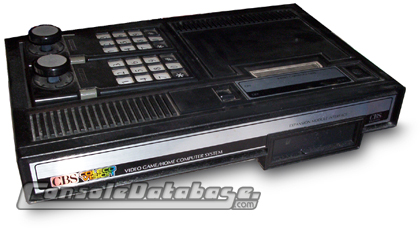![]()
http://www.consoledatabase.com


Coleco Industries was doing quite well with its Telstar pong units, that was until competitors jumped in on the craze and over-saturated the market with clones. The Telstar was pushed even further out of the picture when more advanced consoles with interchangeable cartridges (such as the Atari 2600 and Fairchild Channel F) were introduced. While Coleco managed to survive with its non-electronic toys (such as Cabbage Patch Kids dolls) and their handhelds (which were experiencing some loss of market due to the new consoles with interchangeable games), they needed to get with the times to regain popularity.
Thanks to the Atari 2600 and other popular consoles of the time, the home video game market resurged, and Coleco wanted a piece of the action. By 1981, they had begun development on their new system (to be called the "ColecoVision") that would be superior to the competitors consoles as it would provide arcade quality graphics and gameplay (thanks to a Z-80A processor). Arcade conversions were popular at this time - Atari had built a following around them as they were able to make home versions of their own arcade games. Coleco was not as fortunate. They had no presence in the arcade industry and so they had to get licenses to the rights of arcade games made by other companies. Their first target was the very popular Donkey Kong by Nintendo. An agreement was reached by December 1981. Coleco then proceeded to get licenses for other coin-op games.
The ColecoVision was given controllers similar to the APF Imagination and the Mattel Intellivision and even had the same onboard storage for them. An expansion port was also featured on the ColecoVision, which would be capable of housing future add-on devices.
Coleco first showed their new console at the Consumer Electronics Show in June 1982 and shocked the industry (since Coleco hadn't made any home consoles since the Telstar and had not given any warning of this new console). They began selling their consoles to the public (without FCC approval so they were fined $2000 but were still able to continue producing ColecoVisions) in August for US$175 and had sold 550 000 by Christmas 1982 and proved to be a real winner for Coleco.
Coleco produced a number of devices for the expansion port including a device for playing Atari 2600 games (Expansion Module #1), which caused quite a stir in the industry, and the Super Game Module (Expansion Module #3), which was later released on its own as the Coleco ADAM.
The Coleco ADAM had many problems, costing Coleco both money and credibility. On top of that, these problems were also occurring at the same time as the Great Video Game Market Crash of 1983-84. Coleco stopped production of the ColecoVision in Spring of 1984 to focus on the ADAM computer, believing that they had a greater chance of surviving with the ADAM because of the latest predictions that computers would take over the console market (part of the reason of the crash). But because of the ADAM's many problems, not even it could survive, and was dropped in January 1985, and at the same time Telegames began to release new titles for the ColecoVision. Remaining ColecoVision stock was sold to Telegames.
While Coleco Industries stayed afloat for a while with the production of Cabbage Patch Kids, they eventually filed for bankruptcy in 1988. At this time, Telegames also brought Bit Corp's Dina 2-in-1 clone to America, calling it the Personal Arcade.
Platform: ColecoVision.
Copyright © 2000 - 2025 Base Media. All Rights Reserved. Console Database is a trademark of Base Media. Designated trademarks and brands are the property of their respective owners. Use of this Web site constitutes acceptance of the Base Media User Agreement and Privacy Policy. Our other sites: Deals United - Daily Deals Aggregator and WhichPlug? - Travel Adaptor Finder.